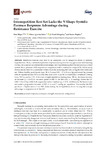Interrepetition rest set lacks the v-shape systolic pressure response advantage during resistance exercise

Ver/
Use este enlace para citar
http://hdl.handle.net/2183/20004
A non ser que se indique outra cousa, a licenza do ítem descríbese como Creative Commons Attribution (CC BY)
Coleccións
- GI-PHG - Artigos [111]
Metadatos
Mostrar o rexistro completo do ítemTítulo
Interrepetition rest set lacks the v-shape systolic pressure response advantage during resistance exerciseData
2017Cita bibliográfica
Mayo, X.; Iglesias-Soler, E.; Kingsley, J.D.; Dopico, X. Interrepetition rest set lacks the v-shape systolic pressure response advantage during resistance exercise. Sports. 2017, 5, 90
Resumo
[Abstract] Resistance exercise may lead to an aneurysm due to dangerous levels of systemic hypertension. Thus, a minimized pressure response during exercise may guarantee safer training. For that, we analyzed an interrepetition rest design (IRD) hypothesizing that it would produce a lower systolic blood pressure (SBP) response in comparison with a continuous design (CD). Additionally, we studied the effect of accumulated repetitions on the increasing SBP rate during the first continuous set. Fifteen healthy participants (age: 24 ± 2 years; SBP: 113 ± 8 mmHg) performed leg presses, with 40 repetitions and 720 s of total rest, structured in an IRD of individual repetitions (resting time: 18.5 s), and in a CD of five sets of eight repetitions (resting time: 180 s). Analyses reported an increase (p = 0.013) in the mean peaks of SBP in the IRD (162 ± 21 mmHg), versus the CD (148 ± 19 mmHg), while both augmented versus baselines (p < 0.001). Additionally, the linear model estimated a progressive increase of SBP of around 7 mmHg per repetition. Summarily, the IRD produced a higher mean of the SBP peaks during the 40 repetitions due to lacking the v-shape advantage in comparison with the CD.
Palabras chave
Pressure response
Aneurysm
Strength exercise
Set configuration
Aneurysm
Strength exercise
Set configuration
Versión do editor
Dereitos
Creative Commons Attribution (CC BY)
ISSN
2075-4663






